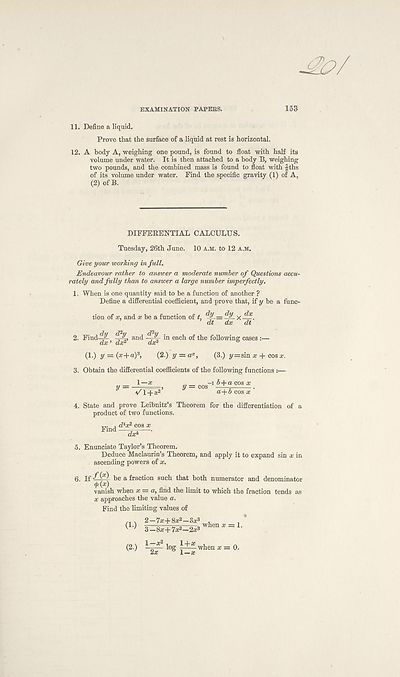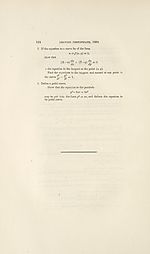Browse and search > 1888 - Leaving Certificate
(36) Differential Calculus
Download files
Complete book:
Individual page:
Thumbnail gallery: Grid view | List view

EXAMINATION PAPEES.
153
11. Define a liquid.
Prove that the surface of a liquid at rest is horizontal.
12. A body A, weighing one pound, is found to float with half its
volume under water. It is then attached to a body B, weighing
two pounds, and the combined mass is found to float with |ths
of its volume under water. Find the specific gravity (1) of A,
(2) of B.
DIFFERENTIAL CALCULUS.
Tuesday, 26th June. 10 a.m. to 12 a.m.
Give your wording in full.
Endeavour rather to answer a moderate number of Questions accu¬
rately and fully than to answer a large number imperfectly.
1. When is one quantity said to be a function of another ?
Define a differential coefficient, and prove that, if y be a func¬
tion of x, and a: be a function of t, x —.
dt dx dt
2. Find-^j^ and in each of the following cases :—
(1.) y = (x+ay, (2.) y — ax, (3.) y=sin x + cos x.
3. Obtain the differential coefficients of the following functions
1—*
y ~ ~vT+P’
3s-i b+a cos x
a+b cos x ’
4. State and prove Leibnitz’s Theorem for the differentiation of a
product of two functions.
Find
d^x2 cos x
daft
5. Enunciate Taylor’s Theorem.
Deduce Maclaurin’s Theorem, and apply it to expand sin x in
ascending powers of x.
6. If be a fraction such that both numerator and denominator
<p(x)
vanish when x = a, find the limit to which the fraction tends as
x approaches the value a.
Find the limiting values of
(1)
2 —7*+8a:2—3a?
3—8a:+7a:2—2a?
when a: = 1.
153
11. Define a liquid.
Prove that the surface of a liquid at rest is horizontal.
12. A body A, weighing one pound, is found to float with half its
volume under water. It is then attached to a body B, weighing
two pounds, and the combined mass is found to float with |ths
of its volume under water. Find the specific gravity (1) of A,
(2) of B.
DIFFERENTIAL CALCULUS.
Tuesday, 26th June. 10 a.m. to 12 a.m.
Give your wording in full.
Endeavour rather to answer a moderate number of Questions accu¬
rately and fully than to answer a large number imperfectly.
1. When is one quantity said to be a function of another ?
Define a differential coefficient, and prove that, if y be a func¬
tion of x, and a: be a function of t, x —.
dt dx dt
2. Find-^j^ and in each of the following cases :—
(1.) y = (x+ay, (2.) y — ax, (3.) y=sin x + cos x.
3. Obtain the differential coefficients of the following functions
1—*
y ~ ~vT+P’
3s-i b+a cos x
a+b cos x ’
4. State and prove Leibnitz’s Theorem for the differentiation of a
product of two functions.
Find
d^x2 cos x
daft
5. Enunciate Taylor’s Theorem.
Deduce Maclaurin’s Theorem, and apply it to expand sin x in
ascending powers of x.
6. If be a fraction such that both numerator and denominator
<p(x)
vanish when x = a, find the limit to which the fraction tends as
x approaches the value a.
Find the limiting values of
(1)
2 —7*+8a:2—3a?
3—8a:+7a:2—2a?
when a: = 1.
Set display mode to:
![]() Universal Viewer |
Universal Viewer | ![]() Mirador |
Large image | Transcription
Mirador |
Large image | Transcription
Images and transcriptions on this page, including medium image downloads, may be used under the Creative Commons Attribution 4.0 International Licence unless otherwise stated. ![]()
| Scottish school exams and circulars > Leaving Certificate > (36) Differential Calculus |
|---|
| Permanent URL | https://digital.nls.uk/144143764 |
|---|---|
| Shelfmark | P.P.1888 XLI |
|---|---|
| Attribution and copyright: |
|
| Description | Examination papers for the School Leaving Certificate 1888-1961 and the Scottish Certificate of Education 1962-1963. Produced by the Scotch (later 'Scottish') Education Department, these exam papers show how education developed in Scotland over this period, with a growing choice of subjects. Comparing them with current exam papers, there are obvious differences in the content and standards of the questions, and also in the layout and use of language |
|---|---|
| Additional NLS resources: |
|



